
The most comprehensive and authoritative history site on the Internet.
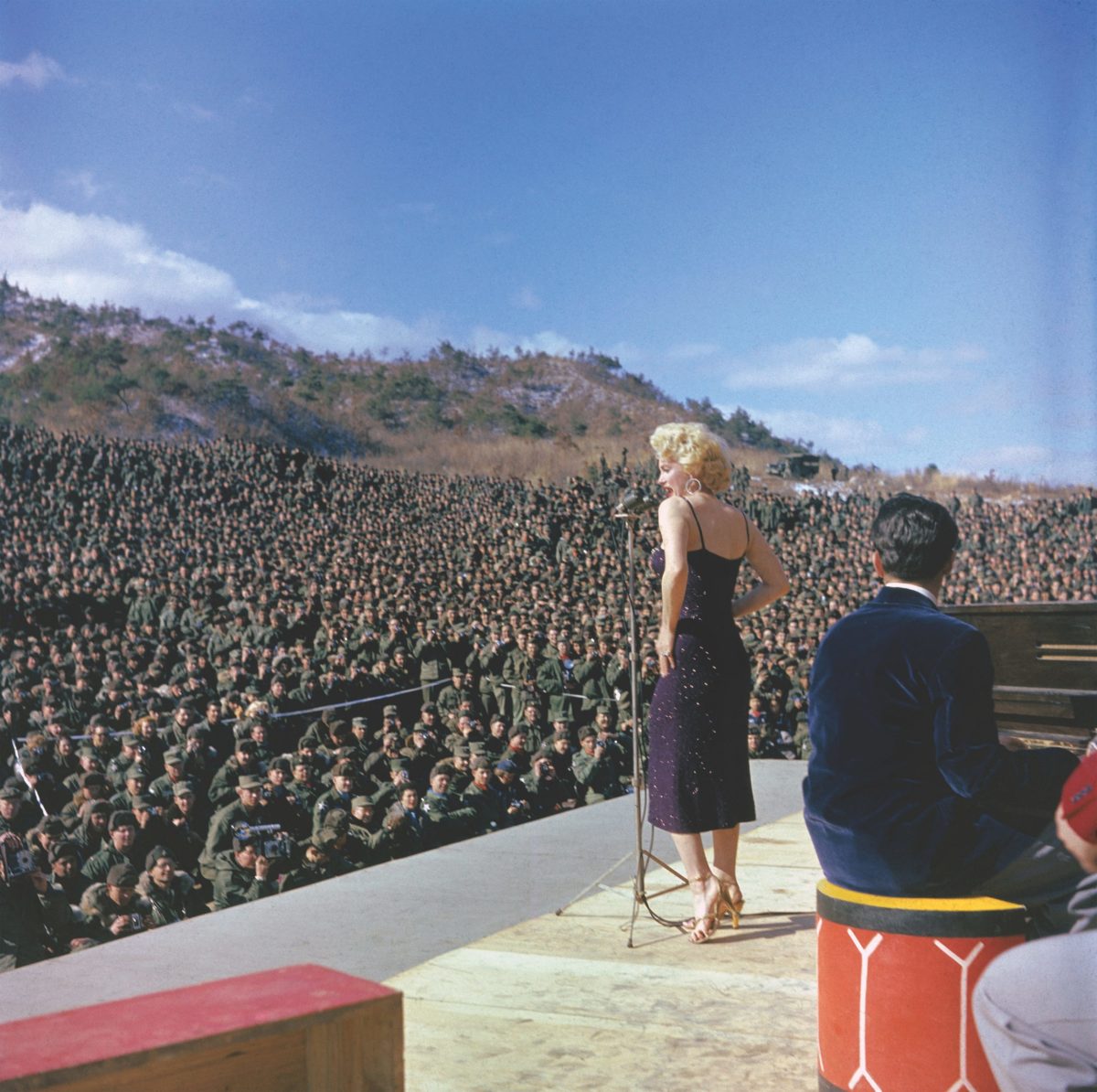

When Marilyn Monroe Interrupted Her Honeymoon to Go to Korea
P an American Airways’ new Boeing 377 Stratocruiser was just beginning its descent into Tokyo on February 1, 1954, when a high-ranking U.S. Army officer approached the plane’s most celebrated passengers: Joe DiMaggio, the New York Yankees legend, and Marilyn Monroe , the famous Hollywood star and sex symbol, whom DiMaggio had married just weeks earlier. Speaking with a slight Texas twang, Major General Charles W. Christenberry, the assistant chief of staff at the army’s Far East Command, leaned over their seats to ask a question. “How would you like to visit Korea for a few days and entertain the American troops currently stationed in Seoul as part of the UN occupation force?” he asked.
“I’d like to,” DiMaggio replied, “but I don’t think I’ll have time this trip.”
“I wasn’t asking you, Mr. DiMaggio,” the general said. “My inquiry was directed at your wife.”
Monroe, a bit startled, looked up. “I’d love to do it,” she told Christenberry. “What do you think, Joe?”
“Go ahead if you want,” DiMaggio told Monroe. “It’s your honeymoon.”
Actually, it was their honeymoon, and it had already gotten off to a rocky start. The couple had tied the knot in a civil ceremony at San Francisco City Hall on January 14, after two years of public, often volatile courtship. The former Norma Jeane Mortensen Dougherty had met her famous second husband on an arranged date in Los Angeles in 1952, when she was 25 and he was 37. Now, after years of paying her dues as a low-billed starlet in Hollywood, Monroe was a red-hot celebrity, while the once-treasured “Yankee Clipper” was fading fast, having walked away from the game three years earlier after a stellar 13-season career patrolling center field in Yankee Stadium. Although neither wanted to admit it, even to themselves, they were moving in opposite directions—fast. Monroe’s whirlwind visit to Korea, as it turned out, only hastened that process.
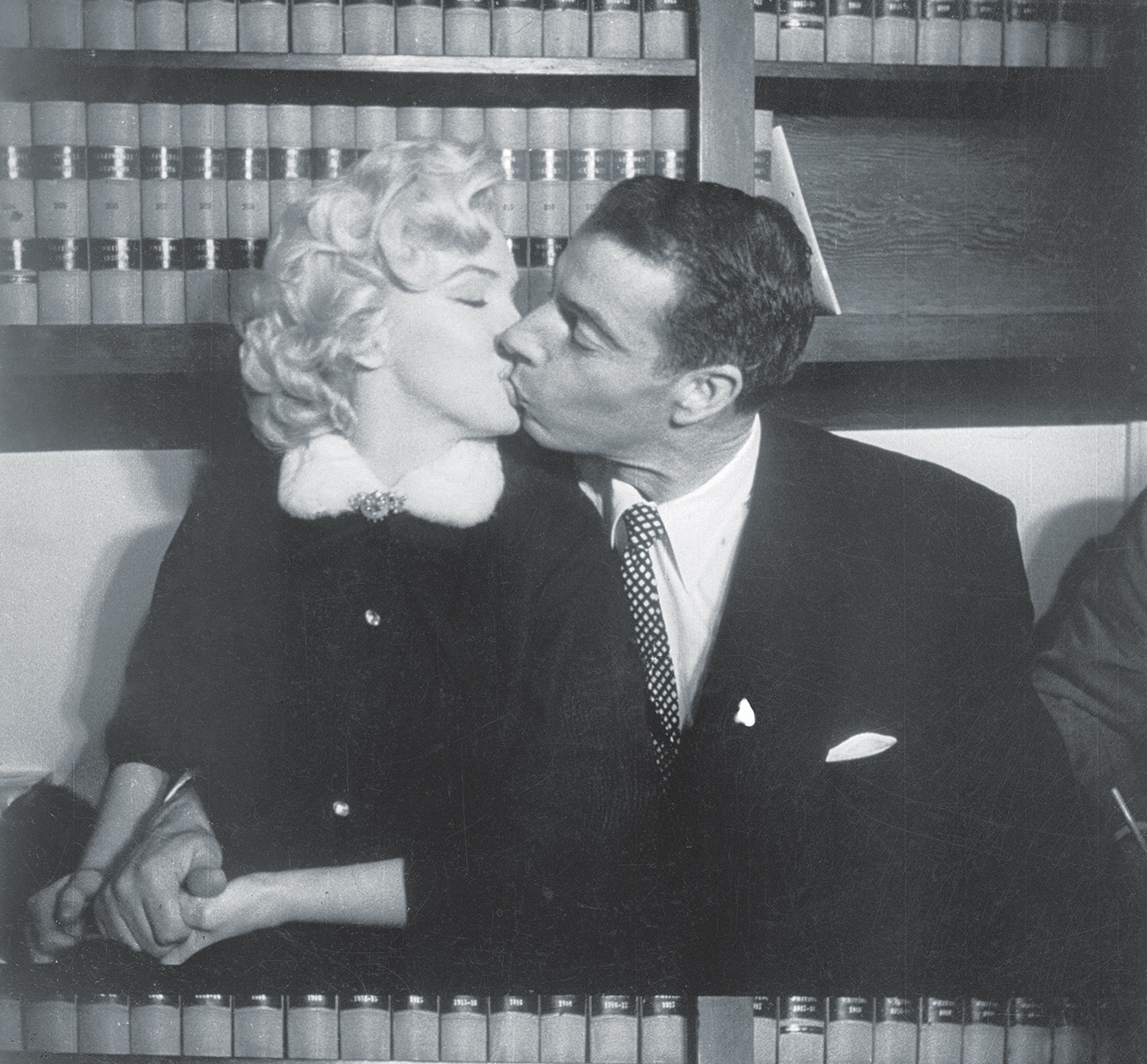
On the surface, DiMaggio and Monroe seemed to be the perfect couple. Both could stop traffic on New York’s Fifth Avenue simply by walking down the street. Restaurants hushed when they entered. But DiMaggio had a reputation among those who knew him for being moody and self-obsessed. The son of Old World Sicilian immigrants, he wanted a doting wife to come home to, someone like his mother and two sisters. Monroe, the daughter of a mentally ill mother, had been passed around often abusive orphanages and foster homes. Unloved and unwanted as a child, she craved love, attention, and public affection. Her career was taking off, even as her new husband was attempting to restrict the type of films she could appear in and putting the kibosh on her sexy attire. (For just that reason she had turned down a juicy part as a schoolmarm turned burlesque dancer in the upcoming movie The Girl in Pink Tights .) Though neither DiMaggio nor Monroe could see it, his attempts to control her career doomed their marriage from the start. Hollywood gossip columnist Louella Parsons predicted as much. “They must resign themselves to the fact that it can’t ever be a completely normal union,” she wrote. “Marilyn will remain in show business and Joe will not be able to take it.”
Monroe pooh-poohed the column. “It’s not like I’m giving up my career,” she told reporters. “I’m simply starting a new one.”
Fifteen days after their wedding, the newlyweds set off for Japan. Before their nuptials, DiMaggio had agreed to accompany an old friend and mentor, ex–major league baseball player Frank “Lefty” O’Doul, to coach and train Japanese baseball teams for the coming season. O’Doul was known as “Mr. Baseball” in Japan for his longtime support of the game there. DiMaggio would take Monroe with him; O’Doul, too, had recently remarried and was bringing his new wife, Jean. Like DiMaggio, O’Doul was a native San Franciscan. He had been DiMaggio’s first manager with the minor league San Francisco Seals, where he had famously announced that the best thing he could do for his budding young star was “change nothing.” The O’Douls were among the half-dozen people who attended DiMaggio and Monroe’s wedding. O’Doul thought the trip to Japan would be a perfect wedding gift for the happy couple. He meant well anyway.
DiMaggio and Monroe arrived to a swarm of fans and photographers at the San Francisco airport. Dressed in a matronly black suit partly offset by a sexy leopard-skin choker, Monroe tried to keep a taped and splinted right thumb hidden beneath her Maximilian “Black Mist” mink coat. When a sharp-eyed member of the press asked about her injury, Monroe replied, somewhat awkwardly, that it was nothing. “I just bumped it,” she said. “I have a witness. Joe was there. He heard it crack.” (Confidential accounts vary, claiming that the contact-averse DiMaggio had instinctively thrown back his right hand when Monroe came up behind him for a hug or else had thrown a glass of water at her during a quarrel. For what it’s worth, Monroe’s nickname for DiMaggio was “Slugger.”)
Just past midnight on January 29, the foursome boarded Pan Am Flight 831 for Tokyo (via Honolulu). The luxurious Stratocruiser, dubbed “the Flying Hotel,” featured a spiral staircase, single beds, and dressing rooms.
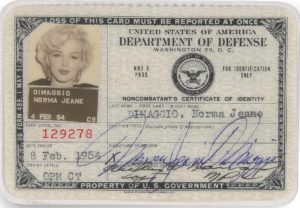
Nine hours later, during a short stopover in Honolulu, hordes of fans swarmed onto the tarmac outside the plane. DiMaggio tried his best to shelter his new bride from the public mayhem. But crazed fans tore at her dress and even pulled at her newly dyed bright-blonde hair. Monroe, United Press International reported, had enjoyed “the most enthusiastic greeting for a movie star in years.” That was one way of putting it.
Their arrival in Tokyo set off a new round of bedlam. Thousands swarmed the airport to catch a glimpse of the blonde beauty, knocking over photographers, airline officials, and policemen. Shouting “ Mon-chan !”—Japanese for “sweet little girl”—the fans broke through barricades and smashed windows, forcing U.S. Air Force MPs to intervene. Monroe and DiMaggio had to squeeze through the plane’s cargo hatch to escape into a waiting car and speed to their hotel.
DiMaggio fully expected to be America’s most exalted celebrity in Japan, but it was Monroe the Japanese people came to see. At the hotel the adoring crowd would not disperse until she agreed to wave goodbye to them from a balcony—“like I was a dictator of something,” she complained. It didn’t help DiMaggio’s mood that some reporters had taken to referring to him as “Mr. Marilyn Monroe.”
At a joint press conference the next day, DiMaggio became livid when all the reporters directed their questions to Monroe, especially since many were impertinent and suggestive. “Do you sleep naked?” “Do you wear anything under your clothes?” “How long have you been walking like that?” Her answers: “No comment,” “I’m planning to buy a kimono tomorrow,” and “I started when I was six months old and I haven’t stopped yet.” More trouble came the following day when a formal invitation arrived from General John E. Hull, the head of the Far East Command, reiterating General Christenberry’s earlier request that Monroe visit Korea to entertain the troops. With DiMaggio and O’Doul likely to be tied up for days preparing the teams in Japan’s Central League for the upcoming season, Monroe thought the visit was a grand idea.
For Monroe, the trip to Korea would represent a grateful repayment of her debt to the thousands of American enlisted men overseas who had showered Hollywood studios with fan letters begging them to put Monroe in more prominent roles. Many of the GIs had never actually seen a Marilyn Monroe film, having been on active duty during her rise to stardom, but they knew her through myriad photographs, especially her nude calendar poses and her appearance on the cover of the premiere issue of Playboy magazine in December 1953, which was hard to come by since the magazine was not sold on military bases. Her photos had replaced those of World War II pinup legend Betty Grable on barracks walls and inside footlockers; Stars and Stripes , the U.S. Army’s newspaper, ran so many photos of Monroe that it had to begin reprising old ones.
this article first appeared in military history quarterly
The Korean War, which began on June 25, 1950, when 75,000 North Korean soldiers invaded South Korea, had subsided—it hadn’t officially ended—a few months before Monroe’s arrival in Japan. Three years of brutal combat had stopped without a formal peace treaty. (To date, none has ever been signed.) The United States had suffered 169,000 casualties in the fighting, including nearly 34,000 killed in action—a remarkably high percentage of KIA. One million American soldiers and marines continued to safeguard South Korea from reinvasion by the North. Monroe couldn’t visit them all, but she would see as many as possible.
On February 8, Monroe received clearance papers and became a USO entertainer. (On her official I.D. card she was Mrs. Norma Jeane DiMaggio, Serial No. 129278.) Preparing like a trouper, with a short dress rehearsal at the Osaka Military Hospital in Japan, Monroe ran through songs with Corporal Al Guastafeste, an army pianist from Unionville, Long Island, and his musical group, Anything Goes. The 21-year-old Guastafeste marveled at the superstar’s lack of ego. “She was Marilyn Monroe, but she didn’t seem to realize it,” he later recalled. “If I made a mistake, she said she was sorry. When she made a mistake she apologized.” After rehearsing, Monroe took time to sign a cast for Corporal Donald L. Wakehouse of Iowa City, Iowa, a returning prisoner of war, and stretched out on the floor of the hospital to smile up at Private Albert Evans of Canton, Ohio, who was suspended upside down over his bed after breaking his back in a jeep accident.
On February 16, after they received vaccinations for cholera and yellow fever, Monroe and Jean O’Doul left Tokyo, escorted by U.S. Army entertainment officer Walter Bouillet. Arriving by helicopter in Seoul, Monroe looked radiant in a flight suit as she stepped out into the damp cold, with her blonde curls perfectly coiffed and a huge smile that could have melted the sun. One of the first enlisted men to see her was Ted Sherman, who had served in the navy during both World War II and the Korean conflict. “I was with a group of Navy guys who happened to be at Daegu Air Force Base when we heard Marilyn would entertain there that night,” he later recalled. “We convinced our transport pilot to find something wrong with our R4D transport so we could delay the return flight to our ship in Tokyo Bay for that one night. The sight and sounds of Marilyn singing ‘Diamonds Are a Girl’s Best Friend’ is a memory I still cherish.”
From Seoul Monroe’s USO entourage immediately set out for the 1st Marine Division camp in the remote and precipitous mountains outside the capital city. Swooping over the camp in their helicopter, Monroe could see thousands of marines crowding the slopes, looking up at her, waving, cheering, and whistling. She told the pilot to circle low so that she could wave back. Then, at great risk to her own safety, she had two soldiers slide open the door of the chopper and hold her by the feet as she lay on her stomach, leaning out the door and blowing kisses to the men below. The marines went wild.
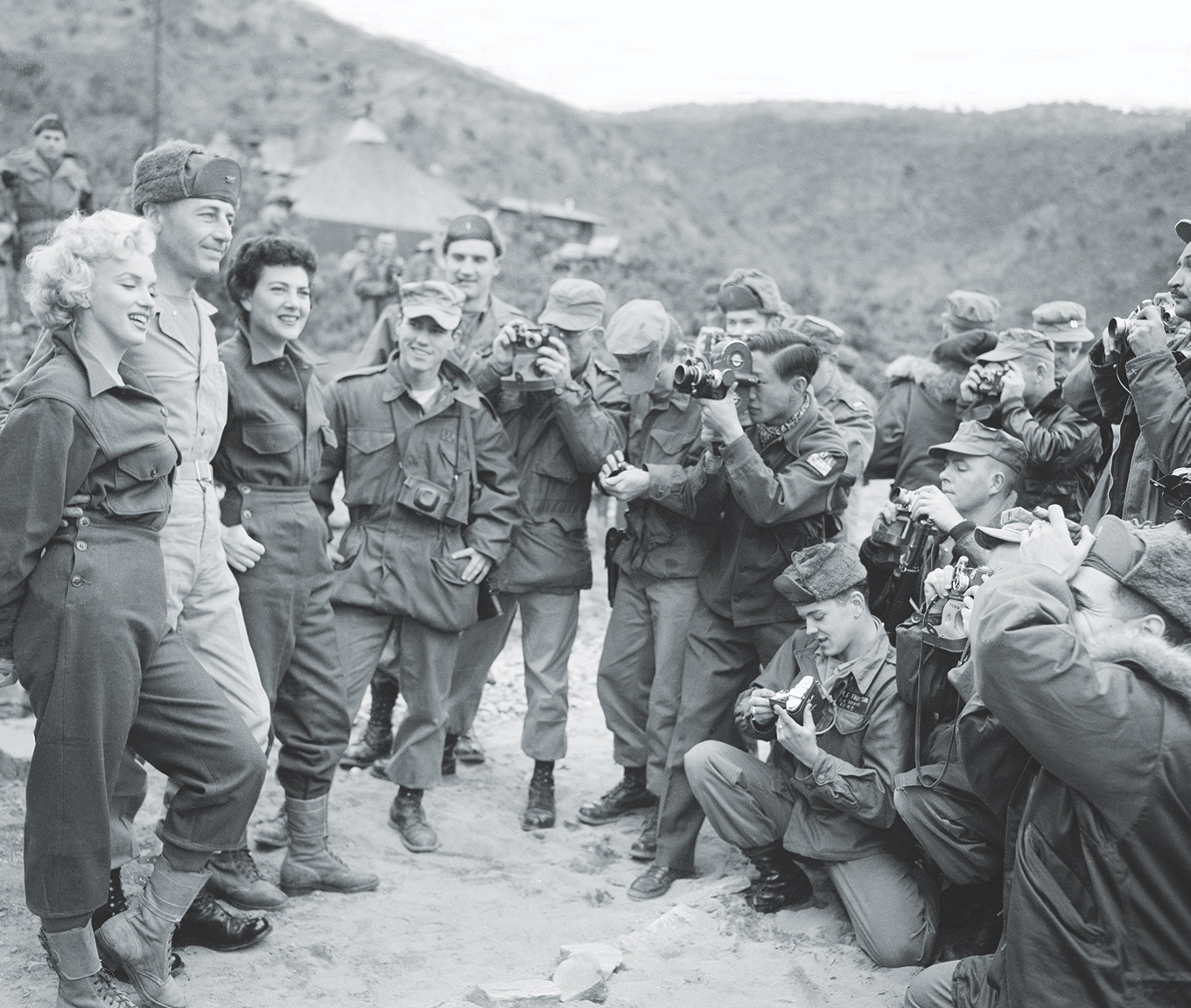
Monroe’s offstage uniform consisted of clam-tight olive drab pants, an olive windbreaker, and rhinestone earrings. Had she been wearing a garbage bag, the men would still have drooled. Once on the ground she changed into a plum-purple (some said lavender) cocktail dress, beneath which she wore nothing, and gold high-heeled sandals. (She would keep the spaghetti-strap dress as a memento for the rest of her life.) Emerging from behind a burlap curtain, she walked out alone onto the makeshift plywood stage to a standing microphone. Snow and sleet peppered the stage. Greeting the marines in her breathy, little-girl voice, she launched into “Diamonds Are a Girl’s Best Friend,” her signature song from Gentlemen Prefer Blondes , her 1953 motion picture. A riot almost broke out when she segued into the come-hither George Gershwin tune “Do It Again.” The men whistled and hollered so much that a worried Walter Bouillet suggested Monroe alter the suggestive words from “do it again” to “kiss me again.” She agreed. “Just kissing,” she promised.
Whatever she sang, the soldiers’ reaction was the same. As Monroe would later tell Hollywood screenwriter and director Ben Hecht: “There were seventeen thousand soldiers in front of me yelling at the top of their lungs. I stood there smiling at them. It had started snowing, but I felt warm, as if I were standing in the bright sun. I’ve always been frightened by large audiences, but standing in the snowfall facing these shouting soldiers, I felt no fear for the first time. I only felt happy. I felt at home.” For a young woman who had never had a real home as a child, it was a particularly welcome feeling. “This is what I’ve always wanted, I guess,” she said.
First Lieutenant George H. Waple III, given the enviable task of looking after Monroe during her Korean tour, always remembered her as being a good sport. “Marilyn never complained,” he recalled. “She seemed to like the basic living arrangement. Her only quibble was with the weather. She hadn’t expected it to be so cold and snowy. I told her I could give her an electric blanket for her cot, but she declined. She also turned down a small electric space heater for the room, saying she didn’t want to be the cause of any concern I might have had for her welfare. She was unspoiled to the nth degree.”
Underscoring Waple’s point, on the flight to the port city of Busan, Monroe excused herself from sitting up front with the generals and colonels and went back to the rear to sit with the band. She made it a point to see that her bandmates and at least 10 enlisted men were invited to every reception in her honor at an officer’s club. “Where I go, they go,” she said of the band. At one wild party at an officers’ club, Monroe accidentally sliced her wrist with a bayonet while trying to cut a cake. An army surgeon general was called in to treat the gash, and reporters were given strict orders not to report the incident. All in attendance had to surrender their photographs, which were immediately burned. The party, the base commander pointedly declared, had never taken place.
On another ice-cold day, Monroe performed at the Bulldozer Bowl—the USO’s stage in the Cheorwon Valley—for the U.S. Army’s 2nd Infantry Division. Soldiers claimed dibs on choice front-row seats seven hours before her performance. Wounded men from sick bay huddled in blue blankets while Monroe braved the chilly temperatures in her revealing summer dress, melting the hearts of the battle-hardened soldiers, many of whom had hiked several miles over frozen mountainous terrain to see her. It was worth the effort. “Marilyn came out dressed in a heavy parka,” recalled Don Loraine, who was in the audience. “She started to sing, suddenly stopped, and said, ‘That’s not what you came to see,’ and took off the parka. She was dressed in a low-cut purple cocktail dress. She was so beautiful, we all went wild, and, I might add, it was colder than hell that day. She brought a lot of joy to a group of combat-weary marines, and I for one will never forget her.”
After the concert Monroe posed for the hundreds of eager fans who crammed the stage. One GI was so flustered that he forgot to remove the lens cap from his camera. “Honey, you forgot to take it off,” Monroe said, removing the cover for him. All available film sold out in army PXs throughout Korea, and so many flashbulbs went off at her performance for the 7th Division that “the Reds probably thought the 7th Infantry Division was on night maneuvers,” one journalist wrote. “The sky kept lighting up from the constant flashing of bulbs as cameras clicked.” In the division’s mess hall afterward, Monroe stopped to eat two cheese omelets, her preferred meal, and noticed a blank spot on the wall behind her. Thinking it might embarrass her, soldiers had removed her ubiquitous “Golden Dreams” calendar, which featured some of the same nude shots of her that had run in Playboy a couple months earlier. But when Monroe spotted one calendar that the men had overlooked, she said, “I’m very pleased to have my picture hanging in a place of honor.”
When another performance was delayed, the troops, crammed in a crowd that stretched a mile long, threatened to raise hell. “I’ve never seen so many men in my life,” Monroe said, overwhelmed by their enthusiasm. For a better view she was lifted onto a tank surrounded by soldiers, posing and waving for all to see. She felt comfortable enough to push through a traffic jam of GIs who hadn’t laid eyes on an American woman for what felt like an eternity. Now they had one of the most gorgeous women in the world singing to them. Signs along the way cautioned troops: “Drive carefully—the life you save may be Marilyn Monroe’s.” Good-naturedly, she posed for a publicity shot with two 25th Division baseball players, wearing a team jacket and hat and holding a bat. She signed each autograph, “Love and Kisses, Marilyn Monroe.”
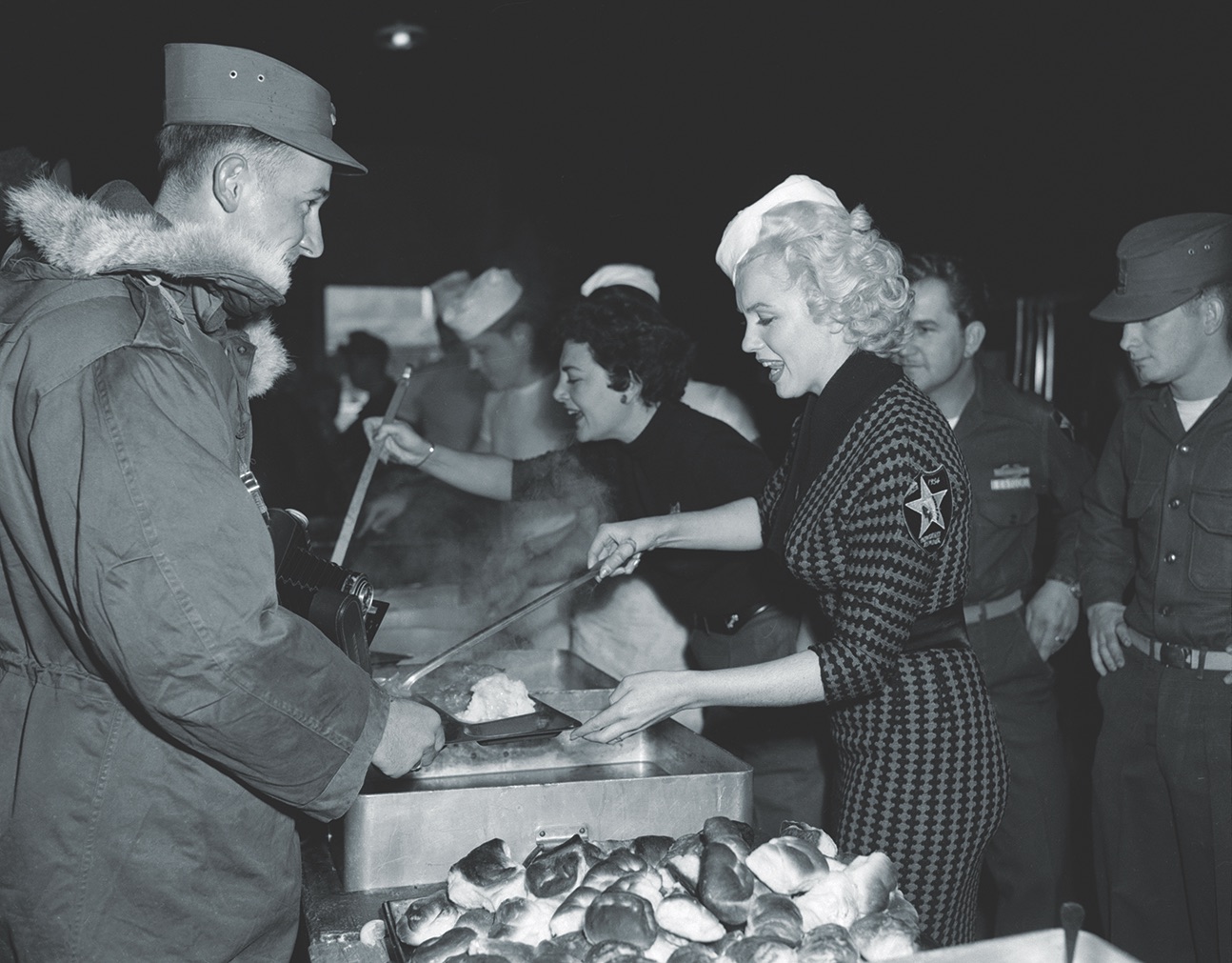
Monroe’s audience at the K-2 Air Base at Daegu consisted of 10,000 Dutch, Thai, and American troops. “She gave us the feeling she really wanted to be there,” recalled Ted Cieszynski, a photographer for the public information office of the Army Corps of Engineers. “Of all the performers who came to us in Korea—and there were a half dozen or so—she was the best. She showed no nervousness and wasn’t anything like a dumb blonde. When a few of us photographers were allowed to climb up on the stage after her show, she was very pleasant and cooperative and told us how glad she was to be with us. She took her time, speaking with each of us about our families and our hometowns and our civilian jobs. It was bitter cold, but she was in no hurry to leave. Marilyn was a great entertainer. She made thousands of GIs feel she really cared.”
Monroe was at her peak in Korea—confident, spontaneous, and heartbreakingly beautiful. She did it all on her own, without the often critical direction of her paid Hollywood handlers or overbearing husband. Following her last show, for the 45th Division, she blew kisses to the audience for a solid half-hour while the men cheered and applauded. “This is my first experience with a live audience, and my greatest experience with any kind of audience,” she told the crowd. “It’s been the best thing that ever happened to me. I’ll never forget my honeymoon—with the 45th Division. Come see me in San Francisco.” With tears in her eyes, she climbed aboard the helicopter to leave, calling out a last farewell: “Goodbye, everyone. Goodbye, goodbye—and God bless you all. Thank you for being so nice. Hold a good thought for me.” For the 100,000 bored and lonely soldiers she had entertained so selflessly in four whirlwind days of nonstop touring, she didn’t even have to ask.
Monroe’s tour in Korea had been an unqualified success, even though she came down with a bad case of bronchial pneumonia from her exposure to the icy conditions there. Those four carefree days not only lifted the spirits of the thousands of homesick young soldiers who saw her but also gave Monroe the genuine outpouring of love she had always craved. Her one-woman performances revealed her true talents and warm personality. “I never really felt like a star,” she told her acting coach, Lotte Goslar, after she returned to the States. “Not really, not in my heart. I felt like one in Korea. It was so wonderful to look down and see all those young fellows smiling up at me. It made me feel wanted.”
After landing in Tokyo, an exuberant Monroe shared her feelings with her husband. “It was so wonderful, Joe,” she said. “You never heard such cheering!”
“Yes, I have,” he replied, accurately if ungraciously.
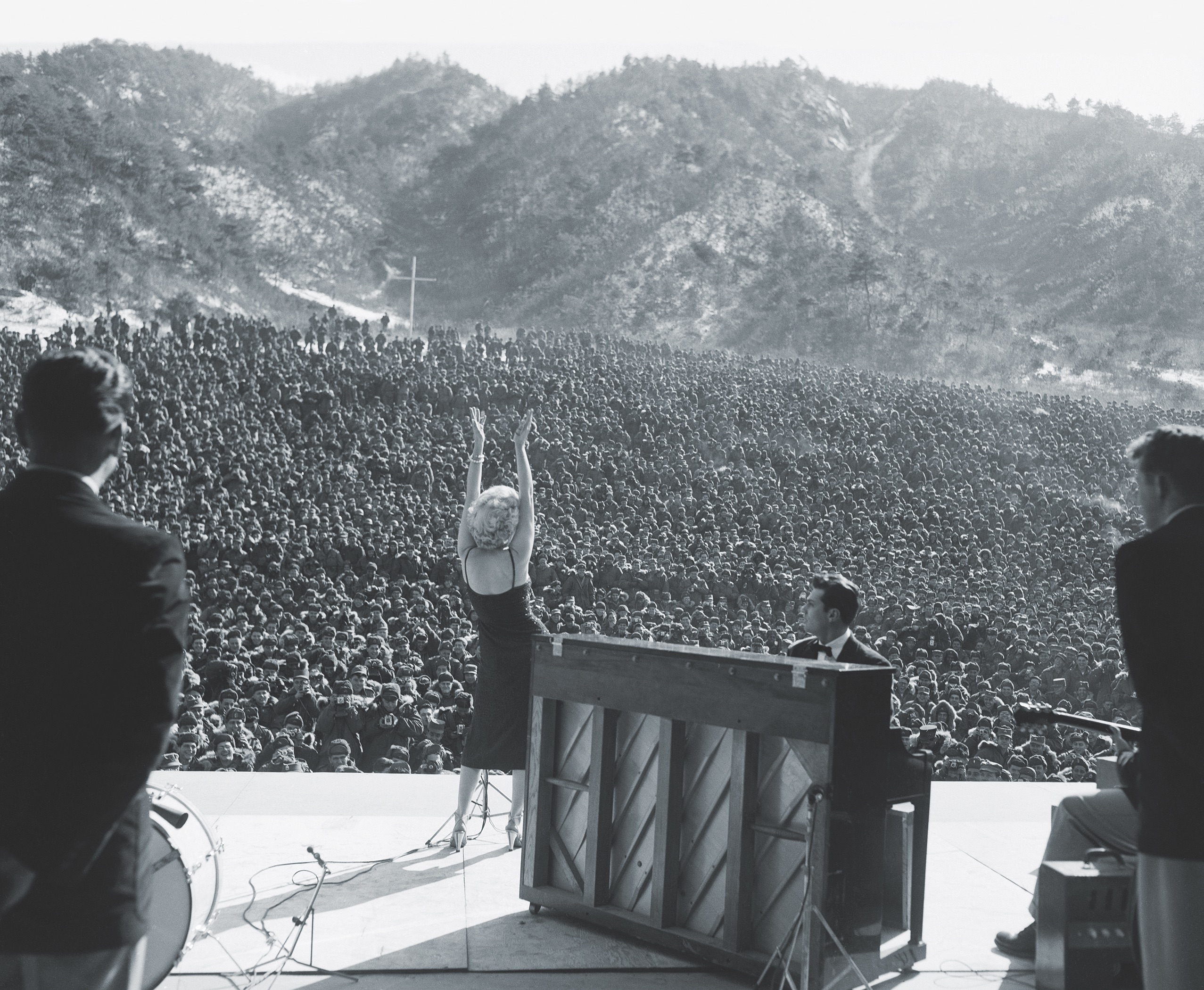
But Monroe’s brief, wondrous trip to Korea turned out to be the beginning of the end of her marriage to DiMaggio. Over the next year and a half the gap between the two of them widened by the day. Ultimately, it was the famous subway grate shot on Lexington Avenue in New York City for Monroe’s next movie, The Seven Year Itch , that was the last straw for DiMaggio, who was on location with her that day. When Monroe’s silky white skirt blew over her head in full view of thousands of bystanders, DiMaggio “had the look of death on his face,” according to Billy Wilder, the film’s director. DiMaggio retreated to Toots Shor’s Restaurant to drown his sorrows. Two weeks later the marriage was over; Monroe filed for divorce. She was genuinely sorry, as she had been after the failure of her first marriage, but this time at least there was one great consolation: She would always have Korea.
Liesl Bradner, a California-based journalist, is the author of Snapdragon: The World War II Exploits of Darby’s Ranger and Combat Photographer Phil Stern (Osprey Publishing, 2018).
Related stories

Portfolio: Images of War as Landscape
Whether they produced battlefield images of the dead or daguerreotype portraits of common soldiers, […]

Jerrie Mock: Record-Breaking American Female Pilot
In 1964 an Ohio woman took up the challenge that had led to Amelia Earhart’s disappearance.

10 Pivotal Events in the Life of Buffalo Bill
William Frederick Cody (1846-1917) led a signal life, from his youthful exploits with the Pony Express and in service as a U.S. Army scout to his globetrotting days as a showman and international icon Buffalo Bill.

The One and Only ‘Booger’ Was Among History’s Best Rodeo Performers
Texan Sam Privett, the colorfully nicknamed proprietor of Booger Red’s Wild West, backed up his boast he could ride anything on four legs.
Vintage Everyday
Bring back some good or bad memories, december 9, 2016, fascinating photographs of marilyn monroe performing for the thousands of american troops in korea, february 1954.

0 comments:
Post a comment.

Browse by Decades
Popular posts.

Advertisement
User validation
- - K-town Now
- Asia-Pacific
- - Storm Tracker
- Middle East
- Map of Memorials
- Entertainment
- - Video Games
- Europe Travel
- - Quick Trips
- - After Hours
- Pacific Travel
- The Meat and Potatoes of Life
- U.S. Travel
- Storm Tracker
- Rewards for readers
- Get Stripes
- Stripes Lite
- Archives/Library
- Special Publications
- Mobile Apps
- Email Newsletters
- Digital Access
- Home Delivery
- Marine Corps
- Coast Guard
- Space Force
- Archive photo of the day
- - Schedules Europe
- - Scoreboards Europe
- - Schedules Pacific
- - Scoreboards Pacific
- - Pacific Sports Blog
- - WW II Podcast
- - Military Matters
- - Force for Hire
- Out of Uniform
- - WW II Videos
- Communities
- Stripes Europe
- Stripes Guam
- Stripes Japan
- Stripes Korea
- Stripes Okinawa
- Our Other Websites
- In Memoriam
- Month of the Military Child
- Best of Germany
- Best of the Pacific
- Letters to Santa
Korean county building dedication to Marilyn Monroe's 1954 USO show
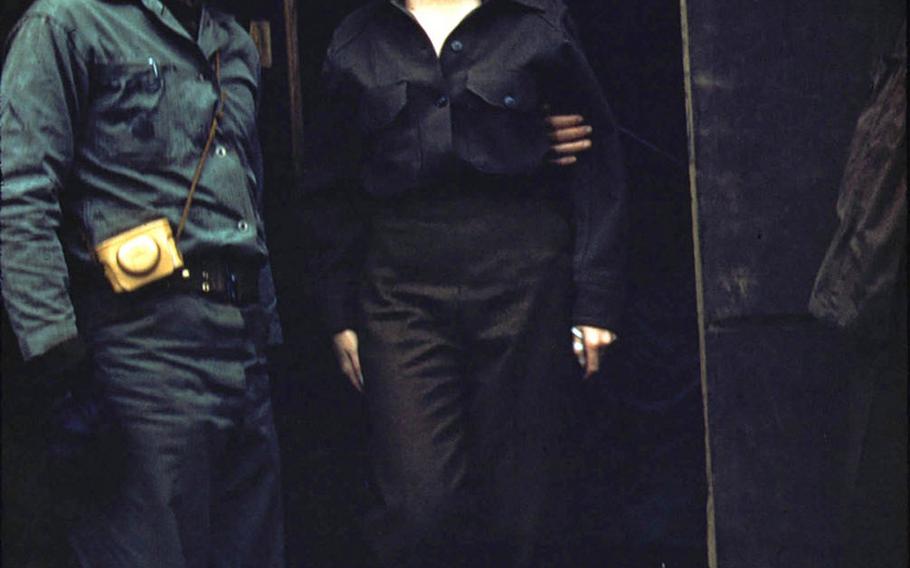
Marilyn Monroe receives an escort while in Korea for her USO tour in 1954.A stone dedication at Inje Country's Catholic church square will recall an era when some of America's biggest stars came to Korea to visit servicemembers during, and soon after the end, of Korean War combat. (Courtesy of U.S. Marine Corps)
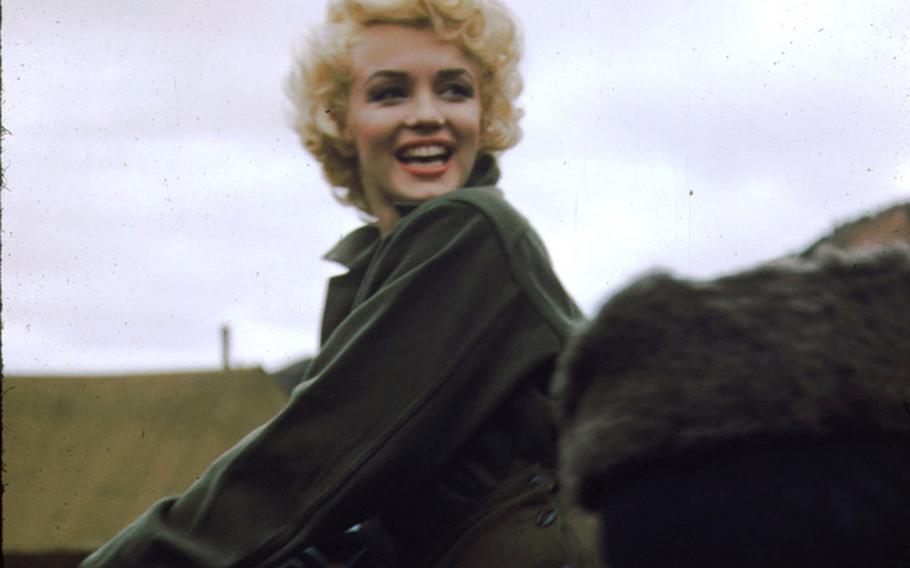
Marilyn Monroe greets the troops during her Korea USO tour in 1954. (Courtesy of U.S. Marine Corps)
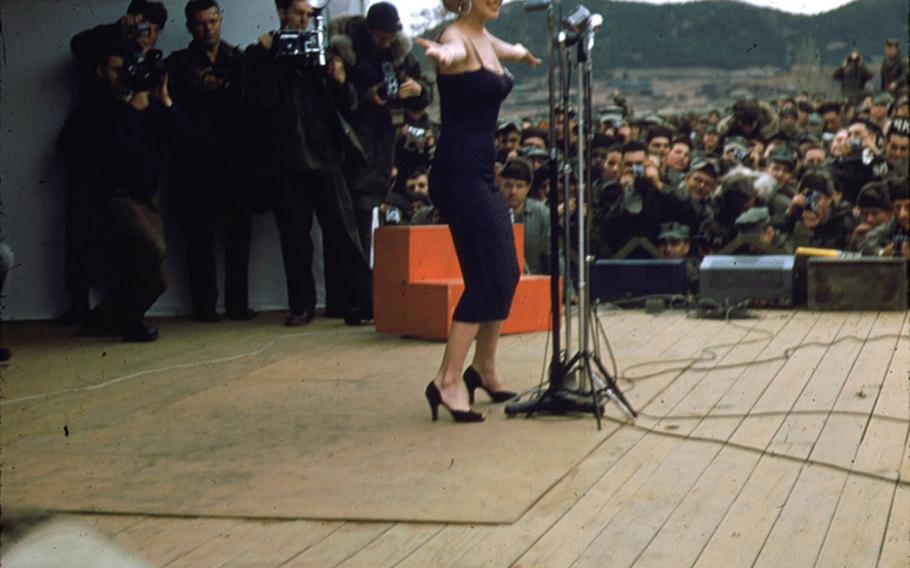
Marilyn Monroe appears onstage entertaining troops on her USO tour through Korea in 1954. A stone dedication at Inje County's Catholic church square will recall an era when some of America's biggest stars came to Korea to visit servicemembers. (Courtesy of U.S. Marine Corps)
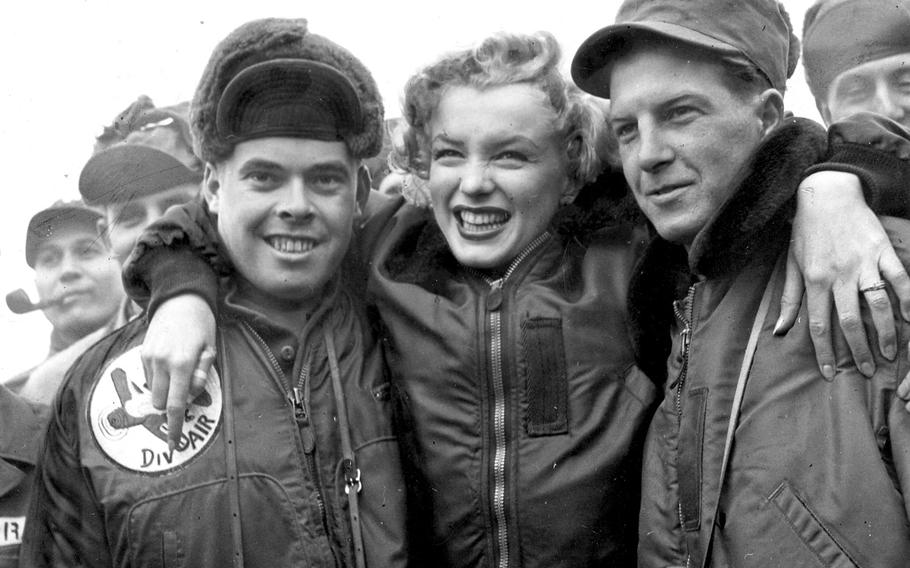
Marilyn Monroe poses with Pfc. John Fenesy, left, of Caldwell, N.J., and Cpl. Dick Armstrong of Williston Park, N.Y., at the 3rd Division airstrip in Korea on February 20, 1954. Inje County, located in the picturesque but sparsely populated northeast, is building a $9,150 dedication to Marilyn Monroe?s 1954 USO show. (Bob Jennings/Stars and Stripes)
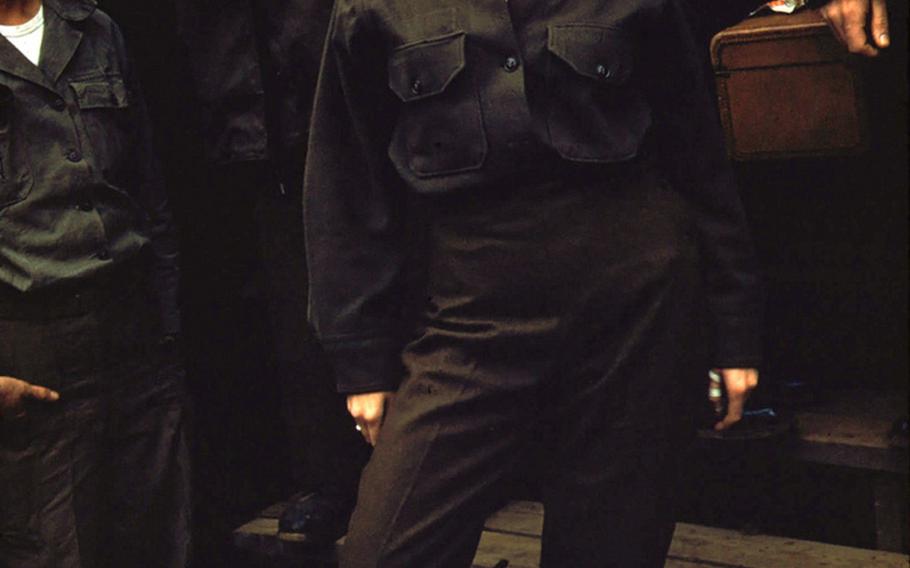
Marilyn Monroe pauses for a photograph while in Korea for a USO tour in 1954. (Courtesy of U.S. Marine Corps)
A small county in South Korea is betting on a legendary blonde’s visit with American troops 61 years ago to bolster its profile.
Inje County, located in the picturesque but sparsely populated northeast, is building a 10 million won ($9,150) dedication to Marilyn Monroe’s 1954 USO show.
The stone dedication at Inje Catholic Church’s square will recall an era when some of America’s biggest stars came to Korea to visit servicemembers during and soon after the end of Korean War combat.
In February 1954, Marilyn Monroe and her new husband, Yankee great Joe DiMaggio, arrived in Japan to massive fanfare. DiMaggio was well-known for his baseball clinics in the country, but it was Monroe who captured more of the country’s attention.
After a few visits with servicemembers at the Tokyo Army Hospital and elsewhere in Japan, Monroe was asked to visit troops in South Korea, a country still very much recovering from the scars of war.
Monroe performed 10 shows in four days for about 100,000 servicemembers, according to the Smithsonian’s National Portrait Gallery, which houses several color pictures of the visit taken by Navy corpsman David Geary.
“[The trip] was the best thing that ever happened to me,” Monroe said, according to the Smithsonian. “I never felt like a star before in my heart. It was so wonderful to look down and see a fellow smiling at me.”
The dedication will include a large picture of servicemembers watching Monroe on stage, with the county’s fields and mountains as a backdrop. An inscription will note how Monroe “soothed the hearts” of U.S. servicemembers at the time.
Monroe’s visit to Korea is well-known among her die-hard fans, though her visit to Inje isn’t mentioned as often in the vast number of books, blogs and other tributes to her life.
Inje is mainly known for its mountains, including Seoraksan National Park, and its proximity to the Demilitarized Zone. County officials hope that recognizing Monroe’s show will cast a little bit of her limelight on them as well.
“We would like to motivate people to know about here,” said Kim Myungsoon, Inje’s public relations spokeswoman. “We’ll try to make good use of it, for not only commemorating her visit to Inje, but also promoting the county’s local culture.”
[email protected] Twitter: @ eslavin_stripes
Sign Up for Daily Headlines
Sign up to receive a daily email of today's top military news stories from Stars and Stripes and top news outlets from around the world.
Sign Up Now
Marilyn Monroe: Fascinating Facts About the Real Woman Behind the Legend
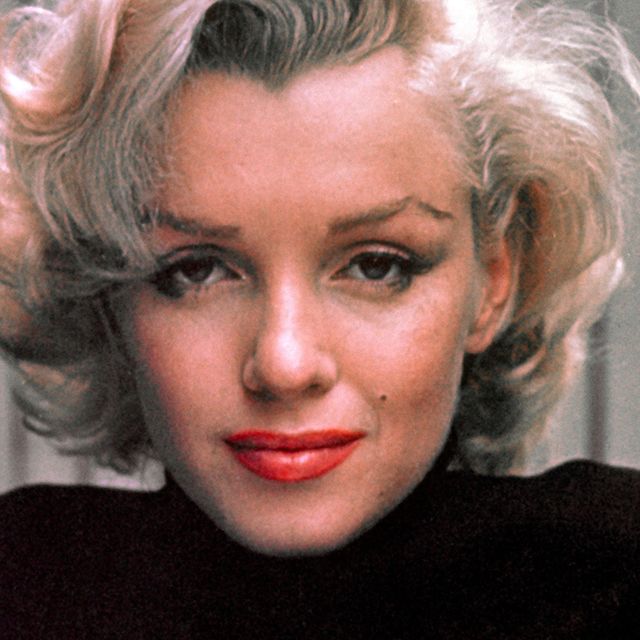
Monroe cut her honeymoon short to entertain the troops
In the early years of World War II , Monroe was a teenaged housewife named Norma Jeane Dougherty. During the war, she went to work in a factory that made military drones. There, she was discovered by a photographer searching for subjects to inspire the troops. Monroe became a model and went on to take risqué pin-up photos that would be hugely popular with soldiers in Korea. After she'd transformed into an actress called Marilyn Monroe, army publication Stars & Stripes dubbed her "Miss Cheesecake of 1951" as her film career was taking off.
Monroe demonstrated her gratitude to these fans by interrupting her honeymoon with second husband Joe DiMaggio to visit troops in Korea in February 1954. Her routine, which featured her onstage in a sparkling purple dress, was a huge hit. She did 10 shows in four days, despite freezing temperatures that contributed to her developing pneumonia. Monroe later noted the experience "was the best thing that ever happened to me. I never felt like a star before in my heart."
READ MORE: Inside Marilyn Monroe and Joe DiMaggio's Roller Coaster Romance
Becoming an A-List movie start didn't come easy
As she started out in the movie industry, Monroe did submit to the casting couch. However, she also worked hard by taking lessons and giving her all to the parts that came her way. To gain experience for a role in B movie Ladies of the Chorus (1948), she performed in a burlesque show under the name "Mona Monroe." For a working-class role in the film Clash by Night (1952), she observed workers in a cannery (and apparently was offered a job beheading fish).
Monroe certainly didn't experience overnight success — she cycled through a couple of movie studios, and saw film contracts expire. But she was always prepared to triumph in her career. At one point she told a friend, "If one hundred percent of the movie big shots in Hollywood told me I couldn’t make it to the top, I wouldn’t believe them."
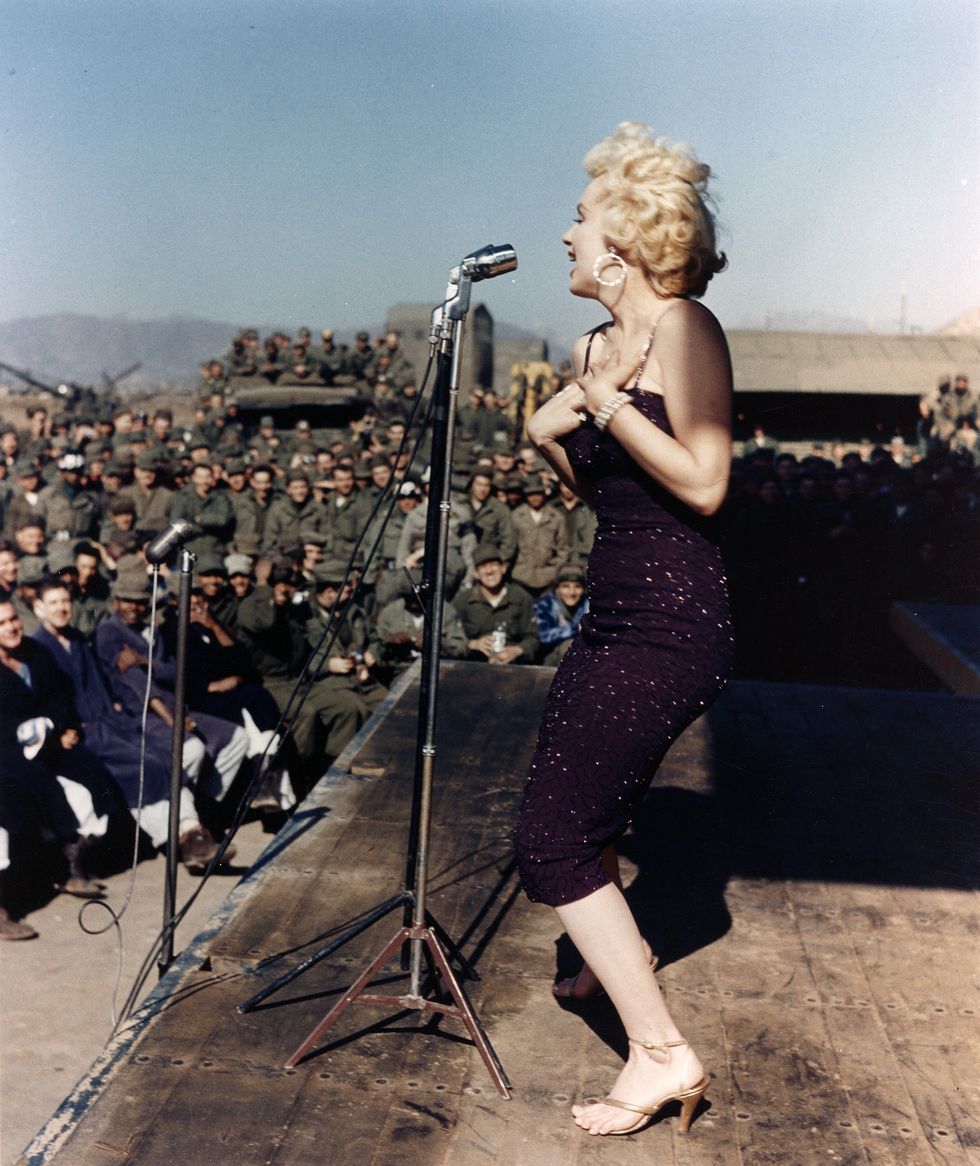
She stood up to HUAC
In 1956, while involved with Monroe, playwright Arthur Miller was called to testify before the House Un-American Activities Committee. Artists who refused to reveal people who'd been involved with Communist activities could be sent to prison for contempt of Congress, but Miller refused to name names. Throughout this ordeal, Monroe remained committed to Miller — despite studio executives and acting teacher Paula Strasberg warning that her decision could expose Monroe to a public backlash that might destroy her career.
Monroe also agreed to marry Miller , even after he surprised her by announcing their wedding plans in his HUAC testimony. Her public display of loyalty likely helped keep him out of prison (Miller was given a suspended sentence for his contempt conviction in 1957; the conviction went on to be overturned in 1958). However, Monroe's actions ended up attracting further interest: Support of Miller, combined with a request she'd made to visit the Soviet Union in 1955 (though she didn't make the trip), prompted the FBI to open a file on her.
READ MORE: Marilyn Monroe and Arthur Miller Had an Instant Connection, But Quickly Grew Apart Once Married
Monroe was an advocate for civil rights
Her relationship with Miller, which ended in divorce in 1961, wasn't the only means by which Monroe became politically aware. With Shelley Winters, a one-time roommate, Monroe attended rallies protesting the violation of civil liberties caused by anti-Communist fervor. She was once chastised for reading a "radical" biography of muckraker Lincoln Steffens on a film set. Having been raised to hold more progressive views on race, Monroe also became an advocate for civil rights.
In 1960, Monroe was elected as an alternate delegate to Connecticut's state Democratic convention (it was a largely honorary position and she didn't attend the gathering). She also once said to reporters, "My nightmare is the H-bomb. What's yours?" — making it unsurprising that she got involved with the Hollywood arm of the Committee for a Sane Nuclear Policy. The FBI, which continued to keep tabs on her, noted in her file in 1962: "Subject's views are very positively and concisely leftist; however, if she is being actively used by the Communist Party, it is not general knowledge among those working with the movement in Los Angeles."
She was institutionalized in 1961
Monroe had a lifelong fear of losing her sanity, something she'd witnessed in her mother . So when Dr. Marianne Kris brought Monroe — who was taking pills, losing weight and not sleeping — to a locked and padded room in New York’s Payne Whitney Clinic in 1961, the patient reacted badly. Desperate to escape, Monroe took inspiration from one of her early films, broke a window and threatened to cut herself with a piece of glass.
This behavior led to Monroe being restrained and carried to another level of the facility, and her desperation grew. Dr. Kris didn't visit; Monroe wrote to Lee and Paula Strasberg, her acting teachers, but they weren't able to obtain her release. Only ex-husband DiMaggio came through, rushing to the facility when he learned what was happening. "I want my wife," he demanded, "And if you do not release her to me, I will take this place apart — piece of wood, by piece . . . of . . . wood." Of course, Monroe was no longer DiMaggio's wife, but the hospital felt the most prudent course was to avoid any potential negative publicity. She was transferred to Columbia University Presbyterian Hospital, where she received treatment in a private room.
READ MORE: How Marilyn Monroe's Childhood Was Disrupted by Her Mother's Paranoid Schizophrenia
Monroe was incredibly generous
Monroe was generous throughout her life, a trait that was apparent even as she spent time in institutions and foster homes. She gave an acting teacher a valuable fur coat and offered money to people in need; shopping companions would often find Monroe had sent them items she'd ostensibly purchased for herself. She was especially generous with children and offered assistance to child-focused charities like the Milk Fund for Babies and the March of Dimes.
That same generosity continues even after Monroe's death . Though most of Monroe's estate went to Strasberg, a portion was left to Dr. Kris. In 1980, Kris bequeathed her part of Monroe's estate to England's Anna Freud Centre . This organization serves children with mental health issues — given her life experiences, it's a cause Monroe would likely be proud to support.

Famous Actors
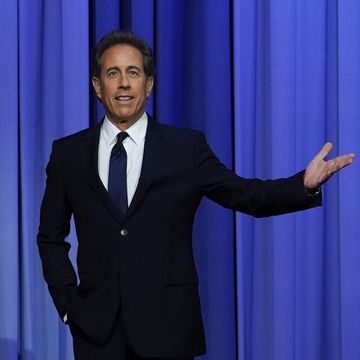
Dakota Fanning

Camila Mendes

Elisabeth Moss

Ryan Reynolds

Kirsten Dunst

Michael Douglas
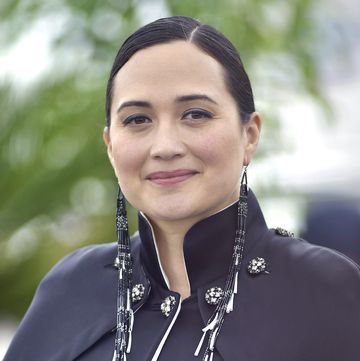
Lily Gladstone

Riley Keough

Oops! Your browser is ancient! :( - Upgrade to a different browser or install Google Chrome Frame to experience this site.
- Find a Post
- Find a Service Officer
- MyLegion.org
- Shop Online

Vet snaps shot with Marilyn Monroe in Korea
Marilyn Monroe was in Korea as part of the USO entertainment during the Korean War. Army veteran Luis Miranda remembers her visit as an inspiration to soldiers. When her helicopter touched down and she stepped on to the base, the whole atmosphere changed.
"It was a surprise to us and the military service because we were not expecting her," Miranda said. "And after all, she was a very important person in the United States." She would soon marry Joe DiMaggio, he said.
It wasn't just that she was blonde, buxom, beautiful. Everyone knew that. She was also kind, professional.
"To me she has a good personality," Miranda said. "She was a happy lady, she was supportive of the troops. She didn’t mention anything about her private life - she was attending the troops."
She didn't perform there, but did make time to meet with the many servicemembers who wanted a brush with fame.
"There were so many people who wanted to talk to her," he said. In his youth, even though Miranda was willing to fight for the United States in war, he was unable to summon the courage to hold court with Monroe, who was "very important" to him.
But he did manage to have a picture snapped of him with the actress. In fact, he's the youngest in the photo, he said.
Plus, the simple act of kindness she made in visiting the troops stuck with him. When she died, Miranda said he felt hurt. He thought of all the soldiers with their pictures. He stressed the importance of her visit, and other visits and shows the USO provided the military.
"It's not easy to be around in an island or a place for 10 or 16 months with the troops," he said. "The USO shows are one of the most important activities that the U.S. Army has because when all the troops are in the field and they get the word that some important person is coming around, they really like it. ... Their feelings go high, really high and they act nice to everyone around."
After that photo was snapped, Miranda went on to serve in the United States, Vietnam, France and Germany before finally retiring from the military as a sergeant first class in the 1970s.
USO shows in both wars helped him maintain morale to serve well. That service, he said, changed his life for the better.
"Believe me. ... Learning all the facts about military life and getting the best of the military life will make you a better person because you have to go through all these frustrations, instructions, people giving you details, obeying the orders, stuff like that. That will make you a better person in my judgment," he said.
One of his sons, David Miranda, also decided to serve. He recently retired from the Navy.
"I’m grateful to the United States and the U.S. forces."
"> img('logo-tagline', [ 'class'=>'full', 'alt'=>'Words Without Borders Logo' ]); ?> -->
- Get Started
- About WWB Campus
- Translationship: Examining the Creative Process Between Authors & Translators
- Ottaway Award
- In the News
- Submissions
Outdated Browser
For the best experience using our website, we recommend upgrading your browser to a newer version or switching to a supported browser.
More Information
Marilyn Monroe and Lady Gaga’s Korea, and Korean Literature
Marilyn Monroe came to South Korea in February of 1954. While honeymooning in Tokyo with Joe DiMaggio, she had boarded a military plane and was en route to Seoul even before the marriage was fully consummated. At the airport, she was swarmed by hundreds of GIs who had been awaiting her arrival. When she came down the gangway, Monroe was dressed in a flight suit. Reporters noted that “half of the buttons on the top were undone, offering tantalizing glimpses of her chest, which got the troops even more riled up.” According to Korean news reports from the time, the GIs were disappointed to see her immediately board a helicopter bound for the frontlines and asked her when she would return, to which she “turned on the charm like a mother comforting a child” and replied, “I’ll be right back.” By February of 1954, the Korean War, which had lasted for three years, had already been brought to an end under the pretext of a ceasefire, but tens of thousands of American soldiers were still stationed in South Korea. Monroe gave dozens of performances, visited wounded soldiers in field hospitals, and posed on top of tanks. In archival photos, the soldiers’ excitement as they greet her is palpable. In colorless, dirt-covered barracks, Monroe alone stands out in color, as if someone had come along later and photoshopped her into the pictures. Before thousands of soldiers seated on a low hill devoid of even a single tree, she spreads her arms wide and sings in time with a piano. The images look like they could have come from a 1960s rock festival.
Yeouido Island, where Monroe alighted from the plane that brought her from Tokyo, is now the center of Seoul. It is crowded with high-rise buildings that house television stations and finance companies. The spot where the airport once stood has been turned into a park. Monroe died never having said anything special about Korea. Which is how it had to be. Because the Korea that she saw in 1954 would have been nothing more than scorched earth, razed to the ground by bombs and cheering GIs.
About half a century after Monroe visited Korea, Lady Gaga came to call. She was giving a concert sponsored by the Korean credit card company Hyundai Card. While Monroe had worn a flight suit, Gaga wore a mask. Where she did resemble Monroe was in her deeply low-cut dress that offered tantalizing glimpses of her chest. The concert was held in April of this year. Though the Korean War has long been over, the scale of U.S. troops stationed in Korea has not lessened much. But Lady Gaga was not here to “comfort” the troops. Instead, she gave what was for her a very modest performance for the tens of thousands of fans, as well as board members of Hyundai Card and their VIP customers, who attended the concert. Also in attendance outside of the concert arena were protestors. You might think they were all old-timers who cling to Confucian tradition, but in fact the protests were led by conservative Christian groups who are influenced by evangelical Christianity in the United States. The close connection between Korean Christianity and American evangelical tradition likewise dates back to the Korean War. After the atomic bombs were dropped on Hiroshima and Nagasaki, and Japan surrendered, the U.S. military entered the Korean peninsula and established a military government. Then the Korean War took place, followed by a succession of pro-American dictatorships in South Korea. To the eyes of Koreans, who had suffered through Japanese colonialism and civil war, the United States was the strongest country in the world, and therefore the God that Americans believed in must also be all-powerful. Korean Christianity grew and grew, and they opposed Lady Gaga just as conservative American Christians did.
Lady Gaga spent three days and two nights in Korea. Of the news reports detailing her movements, the one that caught my attention was a story that took place in a Korean restaurant, where she had gone to eat with her entourage. According to the report, she ate the banchan , the small dishes that accompany a Korean meal, with her hands instead of the chopsticks that had been set out. The January 2012 issue of Vanity Fair describes her wearing Chanel and skillfully making whole-wheat pasta at her parents’ house on the Upper West Side of Manhattan. Somehow I doubt she ate that pasta with her fingers. If she had, the reporter would have been sure to include such an amusing detail. Yet three months after that interview took place, Lady Gaga was eating with her hands in a hotel restaurant in Seoul. Perhaps someone had given her the wrong information. Koreans consider it impolite to eat with one’s hands. Nevertheless, Gaga was not criticized for it. It was merely seen as amusing. Perhaps that is because she is not only famous for her eccentric behavior but was also a guest from a faraway place. But if eating with her fingers was not part of her unique style of eccentricity, then it’s interesting. Throughout her stay in Korea, she barely did anything provocative that would make her audience uncomfortable. Instead, it was her excessively well-behaved and courteous behavior that drew attention. Given the way she behaved during her trip to Korea, eating banchan with her fingers may have even been a kind of gesture of respect. For Koreans, the difference between eating with chopsticks and eating with your hands is like night and day, but for Lady Gaga, there may have been little difference at all. Perhaps in her mind, there is the culture of forks and knives and the “other” culture of everything else.
The Korea that Marilyn Monroe saw was a battleground. The Koreans that Lady Gaga imagined were people who eat with their fingers. Sixty years have passed since Marilyn Monroe boarded a propeller plane and flew here to visit American GIs, but it is possible that views of Korea from the outside have not changed very much. Korea still brings to mind words like war, division, nuclear North Korea, and the Great Leader Kim Jong-il. In literature, as well, the first works to be translated were those that included such themes. Of course, Gaga’s generation is a bit different from Monroe’s. They are more interested in Korean culture than politics (which isn’t very cool), and probably give little thought to an old war that broke out in the 1950s or in a Stalinist state where students march in lockstep down city streets. They probably see Korea as a country of exotic foods and strange living habits. To them, Korea seems to be symbolized by bulgogi and bibimbap, boy groups wearing makeup who command legions of girl fans, and art films rife with cruelty and violence. I encountered both stereotypes frequently while living in New York for two years.
The real Korea lies somewhere between, or perhaps somewhere beyond, Monroe’s Korea and Gaga’s Korea. And as is the case with any country’s serious literature, Korean writers are fighting these stereotypes and working to create their own world. In particular, after the 1990s, when Korea’s economic development accelerated, Korean literature broke free of nationalistic narcissism, the struggle against dictatorship, and the epic narratives of national division and the trauma of war, and began to focus on conspicuously individual issues. Writers who had devoted themselves to social issues began to look inward and question what they could do through language and through fiction. The result was the astonishing diversification of Korean literature. Now, in 2012, I can say that it is all but impossible to briefly summarize current trends in Korean literature.
For this special issue, I selected two short stories. I had hoped to include Park Mingyu’s “Is That So? I’m a Giraffe,” but the story has already appeared in the Asia Literary Review . The stories are all departures from the kinds of stereotypes that readily come to mind when one speaks of Korea or of Korean literature, but at the same time, they show what Korean literature is like at present.
Sim Sangdae’s “Beauty,” written in a mythic style, takes place in a run-down coal mining town. The town, which was once prosperous but is now in ruins, is probably similar to the image of Korea that Monroe would have seen from the airplane: denuded mountains, scorched earth, colorless beings scraping out a living. But even back then, there were those who went to extremes in search of beauty. And that ill-matched aesthetic impulse ends tragically.
Yun Ko-eun is the youngest of the three writers. Her story, “The Chef’s Nail,” which was written in 2011, also takes place on the subway. But it is different from Park’s subway of ten years ago. Park’s pushers are left behind on the platform when the train leaves, but Yun’s characters ride the “Circle Line” around the city all day. For these people, whose job is to advertise books by pretending to read them, the subway is an inescapable reality, a Mobius strip. Their only way out is to become the books that they are selling, and in the end, that is what happens. They are easily replaced and disposed of. In 2011, South Korea was economically more affluent, and yet the prospects for young people in this country have never been bleaker and less stable.
Several months after Hyundai Card invited Lady Gaga to Korea, they also invited Eminem. In the middle of his concert, Eminem raised his arms to form a heart and perplexed the audience, who had been expecting bad manners and crude gestures. Both Lady Gaga and Eminem were so polite and well-behaved. They probably meant no ill intent whatsoever when they ate with their fingers and made hearts with their arms. We all live with misunderstandings about others. And sometimes that’s the more comfortable path. But isn’t literature an art that struggles to overcome stereotypes and easy misunderstandings? I hope that the readers of this special edition will enjoy these three unfamiliar stories from South Korea sent to them from afar.
© Kim Young-ha. By arrangement with the author. Translation © 2012 by Sora Kim-Russell. All rights reserved.
Kim Young-ha
Young-ha Kim is the author of the forthcoming novel I Hear Your Voice , the acclaimed I Have the Right to Destroy Myself , and the award-winning Black Flower .
Sora Kim-Russell
Sora Kim-Russell's publications include Kim Un-su's The Plotters ; Hwang Sok-yong’s At Dusk , Familiar Things , and Princess Bari ; and Pyun Hye-young’s The Law of Lines , City of Ash and Red , and The Hole .
First Read—From “I Hear Your Voice”
Leaving home: korea, your 2024 international women’s day reading list.
- The Collection
- The Exhibits
- The Collector
- Was it THE Dress?
- Say Yes to the Dress(es)
- House & Grounds Part I
- House & Grounds Part II
- Inside Marilyn’s House
- Marilyn’s Bedroom
- Marilyn’s True Size
- Collecting Marilyn
- Photographs
- Awards & Nominations
- Charitable Causes
- The Personal Property of Marilyn Monroe
- Marilyn Monroe & Me
- Marilyn Monroe 50th Anniversary Memorial
- Press & Media

Marilyn Monroe’s Personal Korea Invitation
A 19” x 14” hand-drawn and colored invitation to Marilyn Monroe from the men of Headquarters and Headquarters Company, 2nd Infantry Division, APO 248, U.S. Army, Korea. Note this invitation on the table in the photo below, circled in red.
The invitation reads: “Headquarters and Headquarters Company 2d Inf Division APO 248 US Army. The enlisted men of Headquarters and Headquarters Company 2d Infantry Division, request the pleasure of Marilyn Monroe’s company for lunch at the Headquarters Company Enlisted Men’s Mess Hall 2d Infantry Division Command Post, on Thursday, 18 February, 1954 at 1215 Hours.”
Accompanying the invitation is another panel of similar size with the signed names of approximately 130 enlisted Men of HQ & HQ Co. [FWD], 2d Infantry Division.
In February 1954, Marilyn Monroe and Joe DiMaggio were newlyweds, on a trip in Japan, when the bride took a detour to Korea to entertain the troops. She performed ten shows in four days, in front of audiences that totaled more than 100,000 soldiers and marines. Journalist Hanson Baldwin from the New York Times wrote about Marilyn’s tour: “On two occasions during the visit of the motion picture actress, troops rioted widely and behaved like bobbysoxers in Times Square, not like soldiers proud of their uniform.” Marilyn is reported to have said, “I never thought I had an effect on people until I was in Korea. It was the greatest thing that ever happened to me.”
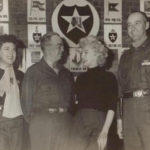
Read about the 2nd Infantry Division here .
Explore the Collection
Follow the mmc.

- Monroe Preservation Group Uncovers the History of “Cursum Perficio”
- In Memory: Anna Strasberg
- Rewriting History: Marilyn Monroe and Stanley Gifford
MMC Instagram
Marilynmonroecollection.
Official account for the Scott Fortner Marilyn Monroe Collection, the world’s largest private collection of Monroe’s personal property & archives.

블로그 마켓 판매자의 이력 관리를 위해 블로그 주소 변경이 불가합니다.
블로그에서 진짜 나를 기록하고 다양한 이웃과 소식을 만나보세요. 지금 시작해볼까요?
- 설정한 아이디는 나중에 변경할 수 없으니 신중하게 입력해주세요.
- 변경 전 공유된 블로그/글/클립 링크는 연결이 끊길 수 있습니다.
- 네이버 아이디 또는 개인정보가 포함된 문자 사용 은 피해주세요.
- 블로그 도움말에서 아이디 변경 유의사항을 확인해보세요.
1. 이전 주소로 공유된 글은 3개월간 새로운 주소로 연결을 지원하며 이후 언제든 연결이 끊길 수 있습니다.
2. 블로그 아이디는 한번 변경하면 다시 변경이 불가능 합니다.
블로그 아이디는 한번 정하면 다시 변경이 불가능합니다.
이 아이디로 블로그를 만들까요?
환영합니다! 블로그 아이디가 만들어졌어요.
기본정보를 입력해주세요..
나중에 언제든지 변경할 수 있어요.

주제를 선택해 주세요.
선택한 주제의 글과 이웃을 추천받을 수 있어요.
인기블로거와 이웃을 맺으세요.
이웃을 맺으면 이웃새글에서 글을 받아볼 수 있어요.
안녕하세요. 이 포스트는 네이버 블로그에서 작성된 게시글입니다. 자세한 내용을 보려면 링크를 클릭해주세요. 감사합니다.
글 보내기 서비스 안내
2009년 6월 30일 네이버 여행 서비스가 종료되었습니다. 네이버 여행 서비스를 이용해 주신 여러분께 감사드리며, 더 좋은 서비스로 보답할 수 있도록 노력하겠습니다.
악성코드가 포함되어 있는 파일입니다.
백신 프로그램으로 치료하신 후 다시 첨부하시거나, 치료가 어려우시면 파일을 삭제하시기 바랍니다.
고객님의 PC가 악성코드에 감염될 경우 시스템성능 저하, 개인정보 유출등의 피해를 입을 수 있으니 주의하시기 바랍니다.
작성자 이외의 방문자에게는 이용이 제한되었습니다.
{ALERTMESSAGE}
이용제한 파일 : {FILENAME}
네이버는 블로그를 통해 저작물이 무단으로 공유되는 것을 막기 위해, 저작권을 침해하는 컨텐츠가 포함되어 있는 게시물의 경우 글보내기 기능을 제한하고 있습니다.
상세한 안내를 받고 싶으신 경우 네이버 고객센터로 문의주시면 도움드리도록 하겠습니다. 건강한 인터넷 환경을 만들어 나갈 수 있도록 고객님의 많은 관심과 협조를 부탁드립니다.
주제 분류 제한 공지
네이버는 블로그를 통해 저작물이 무단으로 공유되는 것을 막기 위해, 저작권을 침해하는 컨텐츠가 포함되어 있는 게시물의 경우 주제 분류 기능을 제한하고 있습니다.
작성하신 게시글 에 사용이 제한된 문구가 포함 되어 일시적으로 등록이 제한됩니다.
이용자 분들이 홍보성 도배, 스팸 게시물로 불편을 겪지 않도록 다음과 같은 경우 해당 게시물 등록이 일시적으로 제한됩니다.
- 특정 게시물 대량으로 등록되거나 해당 게시물에서 자주 사용하는 문구가 포함된 경우
- 특정 게시물이 과도하게 반복 작성되거나 해당 게시물에서 자주 사용하는 문구가 포함된 경우
스팸 게시물이 확대 생성되는 것을 방지하기 위하여 문구 및 사용 제한기간을 상세하게 안내해 드리지 못하는 점 양해 부탁 드립니다. 모두가 행복한 인터넷 문화를 만들기 위한 네이버의 노력이오니 회원님의 양해와 협조 부탁드립니다.
더 궁금하신 사항은 고객센터 로 문의하시면 자세히 알려드리겠습니다.
수정하신 후 다시 등록해 주세요.
회원님의 안전한 서비스 이용을 위해 비밀번호를 확인해 주세요.
다시 한번 비밀번호 확인 하시면 이용중인 화면으로 돌아가며, 작성 중이던 내용을 정상적으로 전송 또는 등록하실 수 있습니다.
공감을 삭제하시겠습니까?
이 글의 공감수도 함께 차감됩니다.
작성하신 에 이용자들의 신고가 많은 표현이 포함 되어 있습니다.
다른 표현을 사용해주시기 바랍니다. 건전한 인터넷 문화 조성을 위해 회원님의 적극적인 협조를 부탁드립니다.
블로그 마켓 가입 완료
내 상품 관리에서 배송비 설정 후 상품 판매를 시작해보세요!

IMAGES
VIDEO
COMMENTS
Marilyn Monroe in Korea. The blonde bombshell visits a war zone. by Alex Q. Arbuckle (opens in a ... In January 1954, Marilyn Monroe and Joe DiMaggio married in San Francisco and jetted off to ...
When Marilyn Monroe left her honeymoon with Joe DiMaggio to entertain the troops in Korea, it was the first time she "felt like a star.". Pan American Airways' new Boeing 377 Stratocruiser was just beginning its descent into Tokyo on February 1, 1954, when a high-ranking U.S. Army officer approached the plane's most celebrated ...
In February 1954, Marilyn Monroe and Joe DiMaggio were newlyweds, on a trip in Japan, when the bride took a detour to Korea to entertain the troops. She performed ten shows in four days, in front of audiences that totaled more than 100,000 soldiers and marines. Later Monroe recalled that the trip "was the best thing that ever happened to me.
Location Unspecified, KoreaMS. Monroe on steps of plane waving. LS. G.I's running. Various shots, Monroe in army uniform walking about. MS. Monroe running up...
A very interesting short documentary about Marilyn's time in Japan and Korea.
A 4″x5″ vintage print black and white snapshot of Marilyn Monroe taken as she is being served a military cafeteria style meal during her visit to entertain United States troops in Korea in February 1954. In February 1954, Marilyn Monroe and Joe DiMaggio were newlyweds, on a trip in Japan, when the bride took a detour to Korea to entertain ...
Marilyn Monroe visits the troops in Korea, entertaining over 100,000 soldiers in 10 different locations, Korea, February, 1954. Marilyn Monroe In Korea. Marilyn Monroe performing for 45th Division in Korea. Marilyn Monroe wearing a skintight purple dress, appeared today before more than 10,000 Marines...
In January 1954, Marilyn Monroe and Joe DiMaggio married in San Francisco and jetted off to Japan for their honeymoon. While DiMaggio attended to his baseball clinics, Monroe took a solo detour to the Korean peninsula, which had been recently divided by the armistice which ended the Korean War the previous year.
Marilyn Monroe visits the troops in Korea, entertaining over 100,000 soldiers in 10 different locations, Korea, February, 1954. Here she is signing an autograph for a happy soldier. Get premium, high resolution news photos at Getty Images
MARILYN VISITS KOREA February 1954 2022-07-07 - Marilyn Monroe travelled to South Korea shortly after the end of the Korean War to entertain American troops. A hastily assembled show called Anything Goes saw her singing to over 100,000 military personnel over four days. A sailor later recalled: "The sight and sounds of Marilyn singing ...
A small county in South Korea is betting on a legendary blonde's visit with American troops 61 years ago to bolster its profile. ... Korean county building dedication to Marilyn Monroe's 1954 ...
Monroe demonstrated her gratitude to these fans by interrupting her honeymoon with second husband Joe DiMaggio to visit troops in Korea in February 1954. Her routine, which featured her onstage in ...
Vet snaps shot with Marilyn Monroe in Korea. Nov 11, 2013. Marilyn Monroe was in Korea as part of the USO entertainment during the Korean War. Army veteran Luis Miranda remembers her visit as an inspiration to soldiers. When her helicopter touched down and she stepped on to the base, the whole atmosphere changed.
The Korea that Marilyn Monroe saw was a battleground. The Koreans that Lady Gaga imagined were people who eat with their fingers. Sixty years have passed since Marilyn Monroe boarded a propeller plane and flew here to visit American GIs, but it is possible that views of Korea from the outside have not changed very much.
Marilyn Monroe was an American actress, model and singer. Born as Norma Jeane Mortenson on June 1st 1926, she became the most famous of Hollywood starlets and was often referred to as the "blonde bombshell" and is still considered an icon today.
This is a video of Marilyn's honeymoon in Japan with former Yankee permanent Joe DiMaggio, when she visited the Tokyo Army Hospital to comfort wounded soldie...
Marilyn Monroe was an American actress, model and singer. Born as Norma Jeane Mortenson on June 1st 1926, she became the most famous of Hollywood starlets and was often referred to as the "blonde bombshell" and is still considered an icon today. ... Marilyn Monroe photographed during her visit to the troops in Korea, February 1954. 1950s ...
An invitation to Marilyn Monroe for lunch with the 2nd Infantry Division, Korea, February 18, 1954. ... marines. Journalist Hanson Baldwin from the New York Times wrote about Marilyn's tour: "On two occasions during the visit of the motion picture actress, troops rioted widely and behaved like bobbysoxers in Times Square, not like soldiers ...
마릴린 먼로는 '조 디마지오'와 일본으로 신혼여행을 갔다, 한국을 방문해 4일간 미군 위문공연...
33 Vintage U.S.O. Tour Photos - From Marilyn Monroe To Frank Sinatra. "Until everyone comes home" is the motto of United Service Organizations (U.S.O.) and since 1941, the nonprofit organization has stuck to that motto, doing its best to bring support and entertainment to American military personnel around the world.